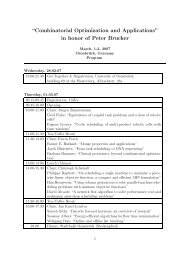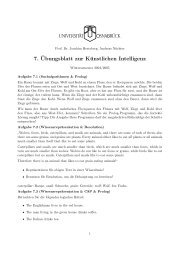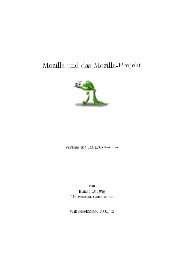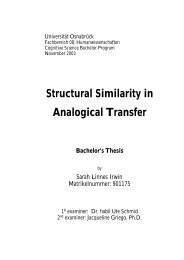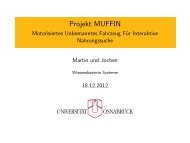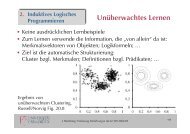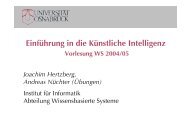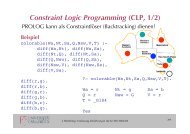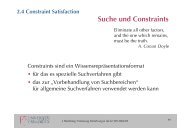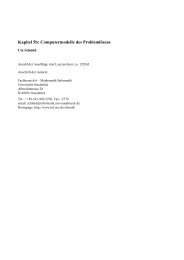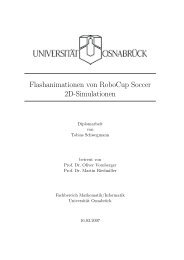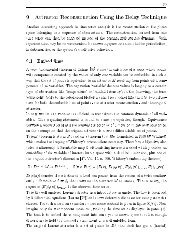Unsupervised Recursive Sequence Processing - Institute of ...
Unsupervised Recursive Sequence Processing - Institute of ...
Unsupervised Recursive Sequence Processing - Institute of ...
You also want an ePaper? Increase the reach of your titles
YUMPU automatically turns print PDFs into web optimized ePapers that Google loves.
<strong>of</strong> neurons, preferably in a topology preserving manner. Prominent applications <strong>of</strong><br />
the SOM are WEBSOM for the retrieval <strong>of</strong> text documents and PicSOM for the<br />
recovery and ordering <strong>of</strong> pictures [18,25]. Various alternatives and extensions to<br />
the standard SOM exist, such as statistical models, growing networks, alternative<br />
lattice structures, or adaptive metrics [3,4,19,27,28,30,33].<br />
If temporal or spatial data are dealt with – like time series, language data, or DNA<br />
strings – sequences <strong>of</strong> potentially unrestricted length constitute a natural domain for<br />
data analysis and classification. Unfortunately, the temporal scope is unknown in<br />
most cases, and therefore fixed vector dimensions, as used for standard SOM, cannot<br />
be applied. Several extensions <strong>of</strong> SOM to sequences have been proposed; for<br />
instance, time-window techniques or the data representation by statistical features<br />
make a processing with standard methods possible [21,28]. Due to data selection or<br />
preprocessing, information might get lost; for this reason, a data-driven adaptation<br />
<strong>of</strong> the metric or the grid is strongly advisable [29,33,36]. The first widely used application<br />
<strong>of</strong> SOM in sequence processing employed the temporal trajectory <strong>of</strong> the<br />
best matching units <strong>of</strong> a standard SOM in order to visualize speech signals and the<br />
variations <strong>of</strong> which [20]. This approach, however, does not operate on sequences<br />
as they are; rather, SOM is used for reducing the dimensionality <strong>of</strong> single sequence<br />
entries and acts as a preprocessing mechanism this way. Proposed alternatives substitute<br />
the standard Euclidean metric by similarity operators on sequences by incorporating<br />
autoregressive processes or time warping strategies [16,26,34]. These<br />
methods are very powerful, but a major problem is their computational costs.<br />
A fundamental way for sequence processing is a recursive approach. Supervised<br />
recurrent networks constitute a well-established generalization <strong>of</strong> standard feedforward<br />
networks to time series; many successful applications for different sequence<br />
classification and regression tasks are known [12,24]. Recurrent unsupervised models<br />
have also been proposed: the temporal Kohonen map (TKM) and the recurrent<br />
SOM (RSOM) use the biologically plausible dynamics <strong>of</strong> leaky integrators [8,39],<br />
as they occur in organisms, and explain phenomena such as direction selectivity<br />
in the visual cortex [9]. Furthermore, the models have been applied with moderate<br />
success to learning tasks [22]. Better results have been achieved by integrating these<br />
models into more complex systems [7,17]. Recent more powerful approaches are<br />
the recursive SOM (RecSOM) and the SOM for structured data (SOMSD) [10,41].<br />
These are based on a richer and explicit representation <strong>of</strong> the temporal context: they<br />
use the activation pr<strong>of</strong>ile <strong>of</strong> the entire map or the index <strong>of</strong> the most recent winner.<br />
As a result, their representation ability is superior to RSOM and TKM.<br />
A proposal to put existing unsupervised recursive models into a taxonomy can be<br />
found in [1,2]. The latter article identifies the entity ’time context’ used by the models<br />
as one <strong>of</strong> the main branches <strong>of</strong> the given taxonomy [2]. Although more general,<br />
the models are still quite diverse, and the recent developments <strong>of</strong> [10,11,35] are<br />
not included in the taxonomy. An earlier, simple, and elegant general description <strong>of</strong><br />
recurrent models with an explicit notion <strong>of</strong> context has been introduced in [13,14].<br />
2





